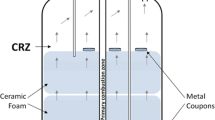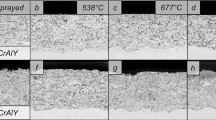Abstract
The effects of fuel sulfur on the hot workability of several nickel-containing alloys have been explored in static exposures and in hot rolling trials following reheating in S-bearing. combustion atmospheres. Using thermochemical calculations, it is shown that the locus of oxidation and sulfidation potentials of such gases over practical air-fuel ratios can be made to coincide for a variety of hydrocarbon fuels, and propane doped with H2S has been used as a fuel to simulate environments resulting from firing distillate and residual oils. Nickel-base alloys containing chromium are not affected by the presence of sulfur species, and workability is independent of reheating conditions at fuel sulfur levels of up to 2 wt pct. Stainless steels may form solid subscale sulfides under air deficient heating, but there is no effect under lean firing conditions; billet workability is not influenced by sulfur. Nickel and nickel-copper alloys form liquid sulfides during air deficient heating, and very poor workability results. Sulfur is also picked up from the gas, and other properties may be affected. The thermochemical predictions for the occurrence of these liquid sulfides agree well with observations. An attempt has been made to identify safe reheating conditions (temperature and air-fuel ratio) for sensitive alloys on the basis of equilibrium combustion gas computations.
Similar content being viewed by others
References
R. Rolls:Met. Treat. DropForg., 1963, p. 427.
A. Preece, G. T. Richardson, and J. W. Cobb:ISI Special Publ., 1939, vol. 24, p. 9.
J. O. Edström:J. Iron Steel Inst., 1957, vol. 185, p. 450.
J. Merrett and R.J. Courtney:ISI Special Publ., 1968, vol. 111,p. 118.
Kirk- Othmer:Encyclopedi of Chemical Technology, 2nd.ed., vol. 6, p. 198, Interscience, NY, 1966.
H. J. Kandiner and S. R. Brinkley:Ind. Eng. Chem., 1950, vol. 42, p. 850.
Joint Army-Navy-Air Force Thermochemical Tables, Dow Chemical Co., Midland, MI, 1965.
R. Lepsoe:Ind. Eng. Chem., 1938, vol. 30, p. 92.
T. Rosenqvist:J. Iron Steel Inst., 1954, vol. 176, p. 37.
Contributions to the Data on Theoretical Metallurgy, vol. XVI, U.S. Bureau of Mines Bulletin 668,1976.
N. Birks:Properties of High Temperature Alloys, Z.A. Foroulis and F. S. Pettit, eds., p. 215, The Electrochemical Society, Princeton, NJ, 1976.
N. Birks:High Temperature Gas-Metal Reactions in Mixed Environments, Z. A. Foroulis and S.A. Jnsson, eds., p. 322, The Metallugical Society of AIME, New York, 1973.
K. T. Jacob, P. B. Rao, and H. G. Nelson:Oxid. Met., 1979, vol. 13, p. 25.
J. Moreau and J. Benard:J. Inst. Metals, 1954–55, vol. 83, p. 87.
N. Birks and H. Rickert:J. Inst. Metals, 1962-63, vol. 91, p. 308.
E. A. Gulbransen and K. F. Andrew:J. Electrochem. Soc, 1954, vol. 101, p. 163.
Author information
Authors and Affiliations
Rights and permissions
About this article
Cite this article
Kane, R.H. Hot workability of nickel-containing alloys after reheating using sulfur-containing fuel. Metall Trans B 11, 147–158 (1980). https://doi.org/10.1007/BF02657184
Received:
Issue Date:
DOI: https://doi.org/10.1007/BF02657184




